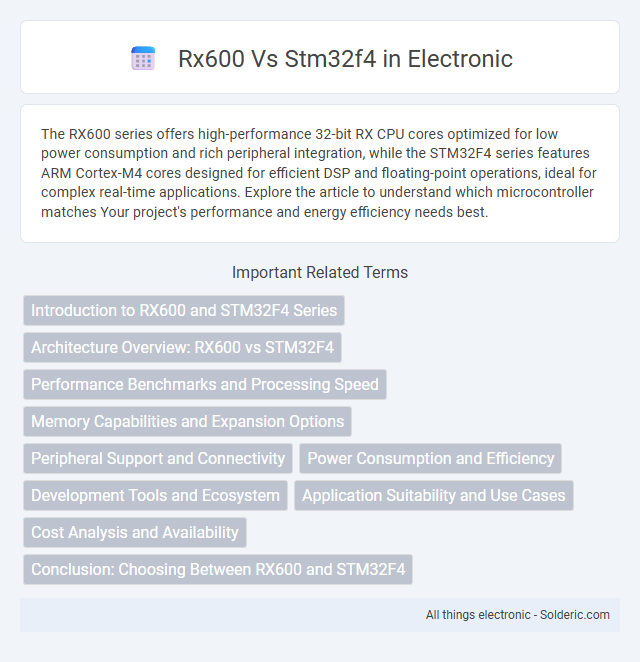The RX600 series offers high-performance 32-bit RX CPU cores optimized for low power consumption and rich peripheral integration, while the STM32F4 series features ARM Cortex-M4 cores designed for efficient DSP and floating-point operations, ideal for complex real-time applications. Explore the article to understand which microcontroller matches Your project's performance and energy efficiency needs best.
Comparison Table
| Feature | Renesas RX600 | ST STM32F4 |
|---|---|---|
| Core | Renesas RX CPU Core (32-bit) | ARM Cortex-M4 (32-bit) |
| Max Clock Speed | 100 MHz | 180 MHz |
| Flash Memory | Up to 4 MB | Up to 2 MB |
| RAM | Up to 512 KB | Up to 384 KB |
| Architecture | CISC | RISC (ARMv7-M) |
| DSP Instructions | No | Yes (FPU and DSP) |
| Peripherals | Extensive: ADC, DAC, Timers, CAN, Ethernet (select models) | Comprehensive: ADC, DAC, Timers, CAN, USB, Ethernet, SDIO |
| Power Consumption | Low power modes available | Optimized low power modes |
| Development Ecosystem | Renesas e2 studio, IAR, GCC | STM32CubeIDE, IAR, Keil, GCC |
| Typical Applications | Industrial control, automotive, automation | Consumer electronics, IoT, industrial automation |
Introduction to RX600 and STM32F4 Series
RX600 series by Renesas features high-performance 32-bit microcontrollers based on the RXv2 core, optimized for real-time control and low power consumption. STM32F4 series, developed by STMicroelectronics, utilizes ARM Cortex-M4 cores, delivering advanced digital signal processing and floating-point capabilities for complex embedded applications. Your choice depends on specific project needs such as processing power, peripheral integration, and development ecosystem.
Architecture Overview: RX600 vs STM32F4
The RX600 series features a 32-bit Renesas RX CPU core optimized for high performance and low power consumption with a 5-stage pipeline, while the STM32F4 series is built on the ARM Cortex-M4 core known for its DSP capabilities and floating-point unit. RX600 supports up to 100 MHz clock speed with highly deterministic instruction execution, contrasting with STM32F4's maximum frequency of 180 MHz offering enhanced computational throughput. Both architectures provide rich peripheral sets, but the RX600 emphasizes deterministic real-time processing, whereas STM32F4 targets DSP-intensive and high-speed control applications.
Performance Benchmarks and Processing Speed
The RX600 series offers high-performance benchmarks with a 32-bit RX core running up to 100 MHz, delivering efficient processing speed ideal for real-time control applications. STM32F4 microcontrollers feature an ARM Cortex-M4 core up to 180 MHz, providing superior floating-point unit (FPU) support and DSP acceleration for complex signal processing tasks. Your choice depends on whether you prioritize raw clock speed with DSP capabilities (STM32F4) or optimized power consumption with consistent throughput in embedded control scenarios (RX600).
Memory Capabilities and Expansion Options
The RX600 series offers up to 2MB of on-chip flash memory and 128KB of RAM, supporting external memory interfaces for significant expansion, ideal for memory-intensive applications. The STM32F4 microcontrollers provide up to 1MB of internal flash and 192KB of SRAM, with flexible external memory controllers such as FMC for SDRAM, SRAM, and NOR/NAND memories. Your choice depends on the specific memory requirements and the need for scalable expansion in embedded system design.
Peripheral Support and Connectivity
The RX600 series offers extensive peripheral support including advanced timers, multiple ADC channels, and high-speed USB interfaces, catering well to industrial automation and motor control applications. In comparison, the STM32F4 family integrates a wide range of connectivity options such as Ethernet, CAN, USB OTG, and high-speed SPI, making it ideal for IoT and multimedia applications requiring versatile communication protocols. Both microcontrollers provide robust UART and I2C modules, but the STM32F4 tends to offer more flexible and higher-performance interfaces suitable for complex embedded systems.
Power Consumption and Efficiency
The Renesas RX600 series is known for its low power consumption, featuring advanced power management modes that optimize efficiency in battery-operated applications. In comparison, the STM32F4 series, built on the ARM Cortex-M4 core, offers competitive performance but generally consumes more power under high processing loads due to its higher clock speeds and DSP capabilities. Designers prioritize the RX600 for energy-sensitive projects, while the STM32F4 balances power and processing power for applications demanding intensive computations.
Development Tools and Ecosystem
The RX600 series offers a comprehensive suite of development tools including Renesas' e2 studio IDE and extensive middleware support, ensuring smooth integration within industrial applications. The STM32F4 benefits from a mature ecosystem with widespread third-party toolchain compatibility such as Keil, IAR, and STM32CubeMX, providing extensive code libraries and community support. Your choice depends on whether you prioritize tightly integrated Renesas-specific tools or a broader, more established ARM Cortex-M ecosystem for rapid prototyping and diverse application development.
Application Suitability and Use Cases
The RX600 series excels in industrial automation and motor control applications due to its high-performance RX cores and integrated analog features, making it ideal for precision control and real-time processing. The STM32F4 series offers robust support for audio processing, advanced connectivity, and multimedia applications, leveraging its Cortex-M4 core with DSP instructions and extensive peripheral set. Your choice depends on whether your project demands industrial-grade real-time control or versatile multimedia functionality.
Cost Analysis and Availability
The RX600 series typically offers a competitive cost advantage over the STM32F4, with pricing often lower due to Renesas' focus on mid-range industrial applications. Availability for the RX600 can be more limited globally compared to the STM32F4, which benefits from STMicroelectronics' extensive distribution and support network. Both microcontrollers show varying lead times, but the STM32F4 generally has stronger supply chain resilience and broader sourcing options.
Conclusion: Choosing Between RX600 and STM32F4
The RX600 series excels in low-power performance and robust motor control features, making it ideal for energy-efficient industrial applications. STM32F4 offers higher processing speeds with advanced DSP capabilities and broader ecosystem support, suitable for complex real-time applications requiring intensive computation. Selection depends on specific project needs: RX600 for power-sensitive, motor-driven designs and STM32F4 for high-performance signal processing and extensive peripheral integration.
rx600 vs stm32f4 Infographic

 solderic.com
solderic.com